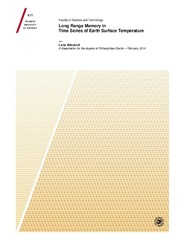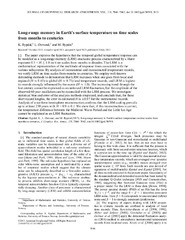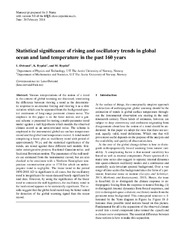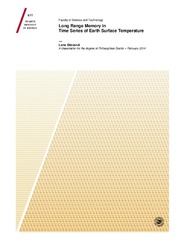| dc.contributor.advisor | Rypdal, Kristoffer | |
| dc.contributor.author | Østvand, Lene | |
| dc.date.accessioned | 2014-06-17T12:48:26Z | |
| dc.date.available | 2014-06-17T12:48:26Z | |
| dc.date.issued | 2014-05-23 | |
| dc.description.abstract | Long-range memory (LRM) has been found in numerous natural data records, both in geophysics and other fields. In this thesis LRM in surface temperature time series is studied, and comparison with short-range memory (SRM) models performed.
Trends are important in climate studies, but the trend definition is ambiguous. Two different approaches are included here: the trend described as a function with parameters estimated from the data, and a response model to external forcing. The most commonly used trend function is the linear trend, often used as a measure of anthropogenic effects on global warming. The significance of the trend is dependent on the noise model assumed to describe the data, and here AR(1) and fractional Gaussian noise (fGn) are used.
Some methods for investigating SRM and LRM are described and applied to some selected examples. Comparison of SRM and LRM models is also included.
The thesis also includes a literature review. In the scientific literature mostly local temperature records have been analysed with regards to LRM. Global and hemispheric temperature means are far less studied, so this has been the main focus in this thesis. Three papers are included where the LRM properties of local and global instrumental records, temperature reconstructions and simulated temperature from climate model experiments are studied. In Paper I and II, a trend analysis is also performed.
The overall conclusion that can be drawn from the present work is that long-range persistence on time scales from years to centuries is ubiquitous in observed Earth surface temperature records, and that similar persistence is present in the most advanced climate models to date. This persistence weakens the significance of observed temperature trends, but not enough to render the rising temperature trends throughout the last century statistically insignificant. | en |
| dc.description.doctoraltype | ph.d. | en |
| dc.description.popularabstract | Langtidshukommelse i overflatetemperatur er studert med ulike metoder. Lokale og globale målinger, temperaturrekonstruksjoner og simulert temperatur fra klimamodeller er analysert. Langtidshukommelse er et eksisterende fenomen i temperaturmålingene på tidsskalaer fra år til århundrer, og innebærer at dagens temperaturer er påvirket av temperatur langt tilbake i tid. Dette blir gjenskapt i de mest avanserte klimamodellene som finnes i dag. Havdynamikk er den viktigste årsaken at langtidshukommelse oppstår. Fenomenet minsker signifikansen til observerte økende trender i temperatur, men kan ikke forklare oppvarming for de siste hundre år alene. Dette er i samsvar med at den viktigste årsaken til global oppvarming er menneskeskapte utslipp. | en |
| dc.identifier.isbn | 978-82-8236-135-4 | |
| dc.identifier.uri | https://hdl.handle.net/10037/6391 | |
| dc.identifier.urn | URN:NBN:no-uit_munin_6016 | |
| dc.language.iso | eng | en |
| dc.publisher | UiT Norges arktiske universitet | en |
| dc.publisher | UiT The Arctic University of Norway | en |
| dc.rights.accessRights | openAccess | |
| dc.rights.holder | Copyright 2014 The Author(s) | |
| dc.rights.uri | https://creativecommons.org/licenses/by-nc-sa/3.0 | en_US |
| dc.rights | Attribution-NonCommercial-ShareAlike 3.0 Unported (CC BY-NC-SA 3.0) | en_US |
| dc.subject | VDP::Mathematics and natural science: 400::Mathematics: 410::Statistics: 412 | en |
| dc.subject | VDP::Matematikk og Naturvitenskap: 400::Matematikk: 410::Statistikk: 412 | en |
| dc.subject | VDP::Mathematics and natural science: 400::Mathematics: 410::Analysis: 411 | en |
| dc.subject | VDP::Matematikk og Naturvitenskap: 400::Matematikk: 410::Analyse: 411 | en |
| dc.title | Long Range Memory in Time Series of Earth Surface Temperature | en |
| dc.type | Doctoral thesis | en |
| dc.type | Doktorgradsavhandling | en |


 English
English norsk
norsk




